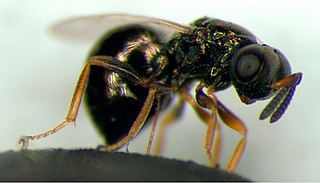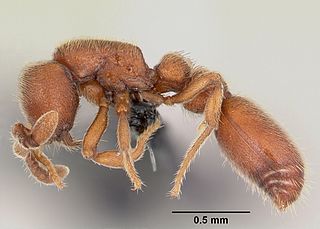Related Research Articles

Reproduction is the biological process by which new individual organisms – "offspring" – are produced from their "parent" or parents. Reproduction is a fundamental feature of all known life; each individual organism exists as the result of reproduction. There are two forms of reproduction: asexual and sexual.
Polygynandry is a mating system in which both males and females have multiple mating partners during a breeding season. In sexually reproducing diploid animals, different mating strategies are employed by males and females, because the cost of gamete production is lower for males than it is for females. The different mating tactics employed by males and females are thought to be the outcome of stochastic reproductive conflicts both ecologically and socially.
A mating system is a way in which a group is structured in relation to sexual behaviour. The precise meaning depends upon the context. With respect to animals, the term describes which males and females mate under which circumstances. Recognised systems include monogamy, polygamy, and promiscuity, all of which lead to different mate choice outcomes and thus these systems affect how sexual selection works in the species which practice them. In plants, the term refers to the degree and circumstances of outcrossing. In human sociobiology, the terms have been extended to encompass the formation of relationships such as marriage.

Wolbachia is a genus of intracellular bacteria that infects mainly arthropod species, including a high proportion of insects, and also some nematodes. It is one of the most common parasitic microbes and is possibly the most common reproductive parasite in the biosphere. Its interactions with its hosts are often complex, and in some cases have evolved to be mutualistic rather than parasitic. Some host species cannot reproduce, or even survive, without Wolbachia colonisation. One study concluded that more than 16% of neotropical insect species carry bacteria of this genus, and as many as 25 to 70% of all insect species are estimated to be potential hosts.

Male is the sex of an organism that produces the gamete known as sperm, which fuses with the larger female gamete, or ovum, in the process of fertilization.

Trichogramma is a genus of minute polyphagous wasps that are endoparasitoids of insect eggs. Trichogramma is one of around 80 genera from the family Trichogrammatidae, with over 200 species worldwide.

Thelytoky is a type of parthenogenesis in which females are produced from unfertilized eggs, as for example in aphids. Thelytokous parthenogenesis is rare among animals and reported in about 1,500 species, about 1 in 1000 of described animal species, according to a 1984 study. It is more common in invertebrates, like arthropods, but it can occur in vertebrates, including salamanders, fish, and reptiles such as some whiptail lizards.

Arrhenotoky, also known as arrhenotokous parthenogenesis, is a form of parthenogenesis in which unfertilized eggs develop into males. In most cases, parthenogenesis produces exclusively female offspring, hence the distinction.

Haplodiploidy is a sex-determination system in which males develop from unfertilized eggs and are haploid, and females develop from fertilized eggs and are diploid. Haplodiploidy is sometimes called arrhenotoky.

The Mediterranean flour moth or mill moth is a moth of the family Pyralidae. It is a common pest of cereal grains, especially flour. This moth is found throughout the world, especially in countries with temperate climates. It prefers warm temperatures for more rapid development, but it can survive a wide range of temperatures.

Parthenogenesis is a natural form of asexual reproduction in which growth and development of embryos occur without fertilization by sperm. In animals, parthenogenesis means development of an embryo from an unfertilized egg cell. In plants parthenogenesis is a component process of apomixis.

Nasonia vitripennis is one of four known species under the genus Nasonia - small parasitoid wasps that afflict the larvae of parasitic carrion flies such as blowflies and flesh flies, which themselves are parasitic toward nestling birds. It is the best known and most widely studied of the parasitoid wasps, and their study forms a vital part of the information used to describe the order Hymenoptera, along with information from bees and ants. This parasitoid behaviour makes the wasps an interest for the development of biopesticide and biological systems for controlling unwanted insects.

A wasp is any insect of the narrow-waisted suborder Apocrita of the order Hymenoptera which is neither a bee nor an ant; this excludes the broad-waisted sawflies (Symphyta), which look somewhat like wasps, but are in a separate suborder. The wasps do not constitute a clade, a complete natural group with a single ancestor, as bees and ants are deeply nested within the wasps, having evolved from wasp ancestors. Wasps that are members of the clade Aculeata can sting their prey.

Sexual reproduction is a type of reproduction that involves a complex life cycle in which a gamete with a single set of chromosomes (haploid) combines with another to produce a zygote that develops into an organism composed of cells with two sets of chromosomes (diploid). Sexual reproduction is the most common life cycle in multicellular eukaryotes, such as animals, fungi and plants. Sexual reproduction does not occur in prokaryotes, but they have processes with similar effects such as bacterial conjugation, transformation and transduction, which may have been precursors to sexual reproduction in early eukaryotes.

Mycocepurus smithii is a species of fungus-growing ant from Latin America. This species is widely distributed geographically and can be found from Mexico in the north to Argentina in the south, as well as on some Caribbean Islands. It lives in a variety of forested habitats and associated open areas. Two studies published in 2009 demonstrated that some populations of the species consist exclusively of females which reproduce via thelytokous parthenogenesis. A detailed study found evidence of sexual reproduction in some populations in the Brazilian Amazon. Accordingly, M. smithii consists of a mosaic of sexually and asexually reproducing populations. In asexual populations all ants in a single colony are female clones of the queen. Inside the colony, the ants cultivate a garden of fungus grown with pieces of dead vegetable matter, dead insects, and insect droppings.
Cytoplasmic incompatibility (CI) is a phenomenon that results in sperm and eggs being unable to form viable offspring. The effect arises from changes in the gamete cells caused by intracellular parasites like Wolbachia, which infect a wide range of insect species. As the reproductive incompatibility is caused by bacteria that reside in the cytoplasm of the host cells, it is referred to as cytoplasmic incompatibility. In 1971, Janice Yen and A. Ralph Barr of UCLA demonstrated the etiologic relationship of Wolbachia infection and cytoplasmic incompatibility in Culex mosquitos when they found that eggs were killed when the sperm of Wolbachia-infected males fertilized infection-free eggs.

Ooceraea biroi, the clonal raider ant, is a queenless clonal ant in the genus Ooceraea. Native to the Asian mainland, this species has become invasive on tropical and subtropical islands throughout the world. Unlike most ants, which have reproductive queens and mostly nonreproductive workers, all individuals in a O. biroi colony reproduce clonally via thelytokous parthenogenesis. Like most dorylines, O. biroi are obligate myrmecophages and raid nests of other ant species to feed on the brood.
Arsenophonus nasoniae is a species of bacterium which was previously isolated from Nasonia vitripennis, a species of parasitoid wasp. These wasps are generalists which afflict the larvae of parasitic carrion flies such as blowflies, houseflies and flesh flies. A. nasoniae belongs to the phylum Pseudomonadota and family Morganellaceae.The genus Arsenophonus, has a close relationship to the Proteus (bacterium) rather than to that of Salmonella and Escherichia. The genus is composed of gammaproteobacterial, secondary-endosymbionts which are gram-negative. Cells are non-flagellated, non-motile, non-spore forming and form long to highly filamentous rods. Cellular division is exhibited through septation. The name 'Arsenophonus nasoniae gen. nov., sp. nov.' was therefore proposed for the discovered bacterium due to its characteristics and its microbial interaction with N. vitripennis. The type strain of A. nasoniae is Strain SKI4.

The Drosophila quinaria species group is a speciose lineage of mushroom-feeding flies studied for their specialist ecology, their parasites, population genetics, and the evolution of immune systems. Quinaria species are part of the Drosophila subgenus.

"Candidatus Cardinium" is a genus of Gram-negative parasitic bacteria that reside within cells of some arthropods and nematodes. Although they have not yet been isolated in pure culture, they are known to negatively influence reproduction in their hosts in order to further their own proliferation. This leads to their classification as a reproductive parasite. One of the only other examples of this type of parasitism is the genus Wolbachia, which also infects arthropods. These two genera can also co-infect the same animal, as in some nematodes. "Candidatus Cardinium" bacteria use many of the same methods to interfere with host reproduction as Wolbachia, including inducing cytoplasmic incompatibility and distorting the sex ratio in the host population to favor females. The mechanisms by which "Candidatus Cardinium" induces these conditions in hosts are thought to be different from the mechanisms used by Wolbachia. "Candidatus Cardinium" bacteria are maternally inherited; infections are maintained through generations through the egg cells. It is estimated that 6–10% of all arthropods are infected with "Candidatus Cardinium" bacteria.
References
- ↑ Myers, P. (2015). "Muscidifurax Uniraptor". The Animal Diversity Web. Retrieved October 21, 2015.
- 1 2 3 4 Zchori-Fein, Einat; Gottlieb, Yuval; Coll, Moshe. "Wolbachia Density and Host Fitness Components in Muscidifurax uniraptor (Hymenoptera: Pteromalidae)" (PDF). Journal of Invertebrate Pathology. 75 (4): 267–272. doi:10.1006/jipa.2000.4927. PMID 10843833 . Retrieved September 22, 2015.
- 1 2 3 Gottlieb, Yuval; Zchori-Fein, Einat (4 September 2002). "Diploidy restoration in Wolbachia-infected Muscidifurax uniraptor (Hymenoptera: Pteromalidae)" (PDF). Journal of Invertebrate Pathology. 81 (3): 166–174. doi:10.1016/s0022-2011(02)00149-0 . Retrieved 21 October 2015.
- ↑ Meer, Marnix M. M. van; Stouthamer, Richard (17 August 1998). "Cross-order transfer of Wolbachia from Muscidifurax uniraptor (Hymenoptera: Pteromalidae) to Drosophila simulans (Diptera: Drosophilidae)". Heredity. 82 (2): 163–169. doi: 10.1038/sj.hdy.6884610 .
- 1 2 Gottlieb, Yuval; Zchori-Fein, Einat (May 1, 2001). "Irreversible thelytokous reproduction in Muscidifurax uniraptor" (PDF). Entomologia Experimentalis et Applicata. 100 (3): 271–278. doi:10.1046/j.1570-7458.2001.00874.x.